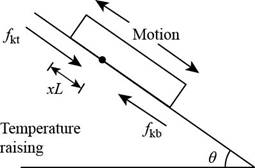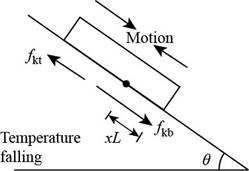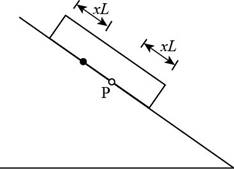
(a)
To show: The stationary line is at distance of
(a)
Answer to Problem 44CP
The distance at which stationary line lie is
Explanation of Solution
Given info: The angle made by the roof with the horizontal plane is
Consider the figure given below.

Figure 1
Consider that
The normal force on the lower part of the plane is,
Here,
The force due to gravity is,
The equation for the
The equation for the downward force is,
The force equation for the plate is,
Further, solve for
The distance of the stationary line below the top edge is,
Conclusion:
Therefore, the distance at which stationary line lie is
(b)
To show: The stationary line is at that same distance above the bottom edge of the plate.
(b)
Answer to Problem 44CP
The stationary line is at that same distance above the bottom edge of the plate.
Explanation of Solution
Given info: The angle made by the roof with the horizontal plane is
Consider the figure given below.

Figure 2
With the temperature falling, the plate contracts faster than the roof. The upper part slides down and feels an upward frictional force,
Then the force equation remains same as in part (a) and the stationary line is above the bottom edge by,
Conclusion:
Therefore, it is proved that the stationary line is at that same distance above the bottom edge of the plate.
(c)
To show: The plate steps down the roof like an inchworm moving each day by the distance
(c)
Answer to Problem 44CP
The distance by which the plate steps down the roof like an inchworm moving each day is
Explanation of Solution
Given info: The angle made by the roof with the horizontal plane is
Consider the figure given below.

Figure 3
Consider the plate at dawn, as the temperature starts to rise. As in part (a), a line at distance
In the above figure, the point
The change in the length of the plate is,
The change in the length of the roof is,
The point on the roof originally under point
When the temperature drops, point
The displacement for a day is,
Substitute
Conclusion:
Therefore, the distance by which the plate steps down the roof like an inchworm moving each day is
(d)
The distance an aluminum plate moves each day.
(d)
Answer to Problem 44CP
The distance an aluminum plate moves each day is
Explanation of Solution
Given info: The angle made by the roof with the horizontal plane is
The length of the plate is
The coefficient of linear expansion for aluminum is
The formula for the displacement for a day is,
Substitute
Conclusion:
Therefore, the distance an aluminum plate moves each day is
(e)
To explain: The effect on the plate if the expansion coefficient of the plate is less than the expansion coefficient of the roof.
(e)
Answer to Problem 44CP
The plate creeps down the roof each day by an amount given by
Explanation of Solution
Given info: The angle made by the roof with the horizontal plane is
If
The figure I, applies to the temperature falling and figure II applies to temperature rising. A point on the plate
The plate creeps down the roof each day by an amount given by,
Conclusion:
Therefore, the plate creeps down the roof each day by an amount given by
Want to see more full solutions like this?
Chapter 18 Solutions
Physics for Scientists and Engineers with Modern Physics
- (a) The inside of a hollow cylinder is maintained at a temperature Ta, and the outside is at a lower temperature, Tb (Fig. P19.45). The wall of the cylinder has a thermal conductivity k. Ignoring end effects, show that the rate of energy conduction from the inner surface to the outer surface in the radial direction is dQdt=2Lk[TaTbln(b/a)] Suggestions: The temperature gradient is dT/dr. A radial energy current passes through a concentric cylinder of area 2rL. (b) The passenger section of a jet airliner is in the shape of a cylindrical tube with a length of 35.0 m and an inner radius of 2.50 m. Its walls are lined with an insulating material 6.00 cm in thickness and having a thermal conductivity of 4.00 105 cal/s cm C. A heater must maintain the interior temperature at 25.0C while the outside temperature is 35.0C. What power must be supplied to the heater? Figure P19.45arrow_forwardThe average coefficient of linear expansion of copper is 17 106 (C)1. The Statue of Liberty is 93 in tall on a summer morning when the temperature is 25C. Assume the copper plates covering the statue are mounted edge to edge without expansion joints and do not buckle or bind on the framework supporting them as the day grows hot. What is the order of magnitude of the statues increase in height? (a) 0.1 mm (b) 1 mm (c) 1 cm (d) 10 cm (e) 1 marrow_forwardAn aluminum rod 0.500 m in length and with a cross-sectional area of 2.50 cm2 is inserted into a thermally insulated vessel containing liquid helium at 4.20 K. The rod is initially at 300 K. (a) If one-half of the rod is inserted into the helium, how many liters of helium boil off by the time the inserted half cools to 4.20 K? Assume the upper half does not yet cool. (b) If the circular surface of the upper end of the rod is maintained at 300 K, what is the approximate boil-off rate of liquid helium in liters per second after the lower half has reached 4.20 K? (Aluminum has thermal conductivity of 3 100 W/m K at 4.20 K; ignore its temperature variation. The density of liquid helium is 125 kg/m3.)arrow_forward
- The rectangular plate shown in Figure P16.60 has an area Ai equal to w. If the temperature increases by T, each dimension increases according to Equation 16.4, where is the average coefficient of linear expansion. (a) Show that the increase in area is A = 2Ai T. (b) What approximation does this expression assume?arrow_forwardA 1.0-m-long steel beam, initially at a temperature of 250 C, increases in temperature to 1000 C by inserting it into an insulating jacket for several minutes while the inside of the jacket is subsequently flooded with steam. By how much does the length of the steel beam expand? (The thermal coefficient of linear expansion for steel is 12 x 10-6 (C0)-1) a. 0.90 mm b. 1.0 mm c. 0.70 mm d. 0.80 mm e. 0.60 mmarrow_forward
 Principles of Physics: A Calculus-Based TextPhysicsISBN:9781133104261Author:Raymond A. Serway, John W. JewettPublisher:Cengage Learning
Principles of Physics: A Calculus-Based TextPhysicsISBN:9781133104261Author:Raymond A. Serway, John W. JewettPublisher:Cengage Learning Physics for Scientists and Engineers: Foundations...PhysicsISBN:9781133939146Author:Katz, Debora M.Publisher:Cengage Learning
Physics for Scientists and Engineers: Foundations...PhysicsISBN:9781133939146Author:Katz, Debora M.Publisher:Cengage Learning Physics for Scientists and Engineers, Technology ...PhysicsISBN:9781305116399Author:Raymond A. Serway, John W. JewettPublisher:Cengage Learning
Physics for Scientists and Engineers, Technology ...PhysicsISBN:9781305116399Author:Raymond A. Serway, John W. JewettPublisher:Cengage Learning Physics for Scientists and Engineers with Modern ...PhysicsISBN:9781337553292Author:Raymond A. Serway, John W. JewettPublisher:Cengage Learning
Physics for Scientists and Engineers with Modern ...PhysicsISBN:9781337553292Author:Raymond A. Serway, John W. JewettPublisher:Cengage Learning Physics for Scientists and EngineersPhysicsISBN:9781337553278Author:Raymond A. Serway, John W. JewettPublisher:Cengage Learning
Physics for Scientists and EngineersPhysicsISBN:9781337553278Author:Raymond A. Serway, John W. JewettPublisher:Cengage Learning




